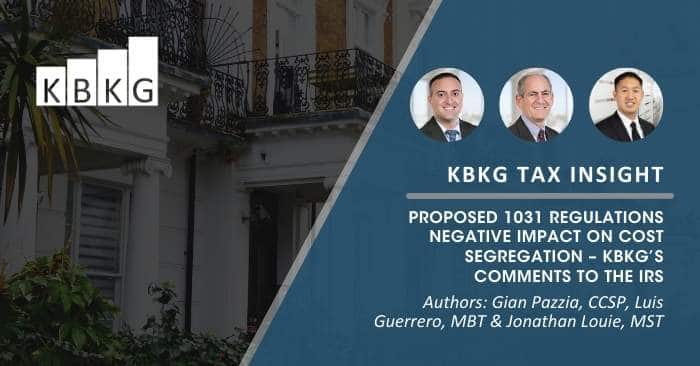On June 12, the IRS issued proposed regulations that define what real property is for purposes of 1031 exchanges. This was in response to changes in the Tax Cuts and Jobs Act (TCJA) that no longer allows personal property from being eligible for 1031 exchange. In their current form, the proposed regulations may create significant federal and state taxable income from the exchange of real estate that did not exist before TCJA. In addition, the proposed definition of real property and personal property under 1031 creates significant taxpayer compliance burdens to identify and value these components. KBKG’s experts have submitted comments on the proposed regulations urging the IRS and Treasury to make substantial changes to these proposed regulations before making them final.
KBKG Insight:
When TCJA was written, the drafters of the revised 1031 legislation included a footnote within the Committee Report stating: “it is intended that real property eligible for like-kind exchange treatment under present law will continue to be eligible or like-kind exchange treatment under the provision.” The proposed regulations, however in their current form, will interfere with the intent of Congress, as explained herein.
Edward C. Schwartz, Esq.
Internal Revenue Service
Associate Chief Counsel (Income Tax & Accounting)
Attn: CC:ITA:B05
1111 Constitution Ave., N.W.
Washington, D.C. 20224
[email protected]
RE: Proposed Regulations 1.1031(a)-3 (REG-117589-18)
Dear Edward,
We hereby offer these comments regarding the proposed Statutory Limitations on Like-Kind Exchanges that were submitted by Federal Register on 06/12/2020. The proposed regulations add a definition of real property to reflect statutory changes limiting section 1031 to exchanges of real property. We would like to thank you for all the efforts at the IRS to help clarify the issues at hand.
The IRS notes the legislative history to the TCJA provides that real property eligible for like-kind exchange treatment under pre-TCJA law should continue to be eligible for like-kind exchange treatment after the enactment of the TCJA. This is also documented by the drafters of this legislation. Specifically, Footnote 726 of the Committee Report states: “it is intended that real property eligible for like-kind exchange treatment under present law will continue to be eligible or like-kind exchange treatment under the provision.”
The proposed regulations, in their current form (including the proposed definition of real property), will interfere with the intent of Congress as explained below. These changes in the treatment of like-kind exchanges will create significant taxable income for many taxpayers that did not exist prior to TCJA. In addition, the proposed definition of real property and personal property under 1031 creates significant taxpayer compliance burdens to identify and value these components.
Our perspective relative to the proposed 1031 regulations relates specifically to properties that have had cost segregation studies prior to being exchanged. As cost segregation studies have become commonplace within the real estate industry, it is important to highlight this impact.
Clarification of Proposed Regulations
Our comments start with the following requests for clarification.
- As it relates to the test where components are not real property if they are used to produce income for the business. For a professional service company’s office building, does wiring in the walls installed specifically for computer workstations meet this test because the computers are being used to produce income for the business?
- Will carpeting in an office building be considered real property or personal property under the proposed regulations. Please outline your analysis.
Prior Law vs. Proposed Regulations – Functional Test
As noted in the proposed regulations, the definition of real property for purposes of 1031 exchanges does not need to match other sections of the tax code, as each section was written for different purposes and with different intent. Although unclear, under prior law, components that are generally permanently affixed to a building and considered real property under state law would be eligible for like-kind exchange treatment. There was never any requirement to consider other factors, such as the function of each building component. For example, under prior law, gas piping within the walls of a restaurant kitchen that is necessary to enable the cooking equipment to be functional was considered real property for 1031 exchange purposes. As a side note that we will reference later, this property would be entitled to 5-year MACRS depreciation treatment. As such, we will refer to this property at 1245 Real Property going forward.
The proposed regulations, however change prior law by making it no longer eligible for 1031 exchange. We believe this goes against the intent of Congress and believe the function of a distinct asset that is not machinery is not appropriate to use as the basis for determining whether the asset is real property under 1031. Further – our example below demonstrates that this creates taxable income that would not have been created in pre-TCJA exchanges of real property. See below.
Proposed 1031 Regs Create Taxable Income That Did Not Exist in Pre-TCJA Exchanges
Case Study: Property A originally purchased in December 2017 for $8M ($5.6M blg + $2.4M land). Cost Segregation allocations are:
| Tax Class | Property A Tax Bases |
| 5-year property | $1.1M |
| 39-year property | $4.5M |
| Land | $2.4M |
| Total | $8.0M |
In November of 2019, Property A is sold in a 1031 exchange for $10 million ($7M blg + $3M land). Property A’s undepreciated/carryover basis = $6.7M ($4.3M blg + 2.4M land).
In February of 2020, Property B is purchased in the 1031 exchange for $10M ($7M blg + $3M land). Property B Cost Segregation allocations are:
| Tax Class | Property B Fair Market Value |
| 5-year property | $1.4M |
| 39-year property | $5.6M |
| Land | $3.0M |
| Total | $10.0M |
Before TCJA, there would be zero federal and state taxable income from this exchange as the 5-year property fair market value from Property B ($1.4M) exceeds the value from Property A ($1.1M).
Timing Difference
The proposed regulations note that personal property of equal or greater value from the newly purchased property (Property B) is eligible for 100% bonus depreciation and will offset recapture tax on the relinquished property. However, under the proposed regulations assuming 100% bonus depreciation, there will be a $1.1M gain subject to recapture tax due for the 2019 tax year. The offsetting bonus depreciation from Property B will not be available until the 2020 tax year due to transaction timing. This timing issue will be a significant problem for many taxpayers.
Expiration of Bonus Depreciation
The proposed regulations acknowledge that when 100% bonus depreciation expires after 2022, the federal tax liability associated with a 1031 exchange for real estate containing personal property will increase. The increase could be significant, depending on the fact pattern of the exchange. We do not think this should be taken lightly. A change this large in the exchange of real estate was not the intent of Congress.
State Tax Implications
The new regulations would ignore the historical consideration of state treatment of what is real property and what is not. This by itself contradicts the congressional intent, but it would also create a disconnect between federal and state tax return reporting. You could have exchanges for federal and state purposes that look completely different. The amount of real property in the federal exchange would be a lower amount than what would likely be used for the state tax return, substantially increasing the complexity of exchanges.
Finally, the proposed regulation specifically calls for the elimination of case law as a factor in addressing the nature of a property exchange. This not only ignores decades of precedent, but it is also inconsistent with the congressional intent to not impact what exchanges qualified by virtue of the new law. We respectfully request that this portion of the proposed regulation be eliminated.
Increased Burdens on Taxpayers
There is a long history of tax court cases and precedents that make it clear that nearly every real estate transaction involving a building will contain a significant amount of components that would be considered personal property under these proposed regulations. Historically, these assets were treated as real property for 1031 purposes but were treated as 1245 Real Property for depreciation purposes. If these regulations are finalized in their current form, it seems unreasonable to expect taxpayers to be able to quantify these values for 1031 exchange purposes without having to hire a specialist to do it for them. By adopting our suggestions below, we can eliminate this increased burden.
The Incidental Rule Comments
Using a limit of 15% for incidental property will disqualify some 1031 exchanges under the proposed regulations. If the intent is to provide certainty as to what happens when true personal property is included in an exchange, then we would advise changing the language to clarify that any incidental non like-kind property received in an exchange be treated as boot rather than implementing a safe harbor to determine the validity of an entire exchange. By implementing the safe harbor for incidental property, an unintended burden will be placed on taxpayers as they will need to have a valuation prepared for every property involved in an exchange in order to confirm that the incidental safe harbor rule is satisfied. We don’t believe that it was Congress’ intent to place such a burden on taxpayers involved in 1031 exchanges. If our suggested changes are not made to the definition of real property, we suggest modifying this incidental safe harbor rule by using a 20% fair market value of the replacement property as the limit in order to minimize the impact of the potential consequences to taxpayers.
In Conclusion
In order to be consistent with prior law and provide clarity for taxpayers, we offer the following suggestion for the definition of real property for 1031 exchange purposes:
- Real property includes land, inherently permanent structures, structural components of inherently permanent structures, and any component affixed to real property that is treated as real property under state law.
For clarification, this includes but is not limited to:
- Any plumbing, electrical, and HVAC components that are affixed to the building, regardless of its function or use.
- Machinery such as an emergency generator that is not reasonably expected to be removed from the building if the existing business operations are relocated.
- Any building component, such as raised flooring in a server room that is not reasonably expected to be removed from the building if the existing business operations are relocated
To find out if a Cost Segregation Study will benefit you, visit: KBKG.com/costsegregation
Authors: Gian Pazzia, CCSP, Luis A. Guerrero, MBT, & Jonathan Louie, MST
About the Authors
 Gian Pazzia, CCSP – Principal
Gian Pazzia, CCSP – Principal
Pasadena
Gian oversees KBKG’s Cost Segregation group nationally from our Pasadena headquarters. He is also a subject matter expert for 263(a) Repairs vs. Capitalization services. Gian is a recognized leader in the cost segregation field serving as a former President (2013-2015 term) of the American Society of Cost Segregation Professionals and holding a seat on their Board of Directors for a decade. » Full Bio
 Luis (Lou) Guerrero, MBT – Principal
Luis (Lou) Guerrero, MBT – Principal
Woodland Hills
Based in Woodland Hills, Luis A. Guerrero, MBT, is a Principal and Co-Founder of KBKG, Tax Credit, Incentives & Cost Recovery Specialists. As the Tax Practice Leader, he is responsible for leading a team of engineers and accountants with addressing tax-related matters. » Full Bio


